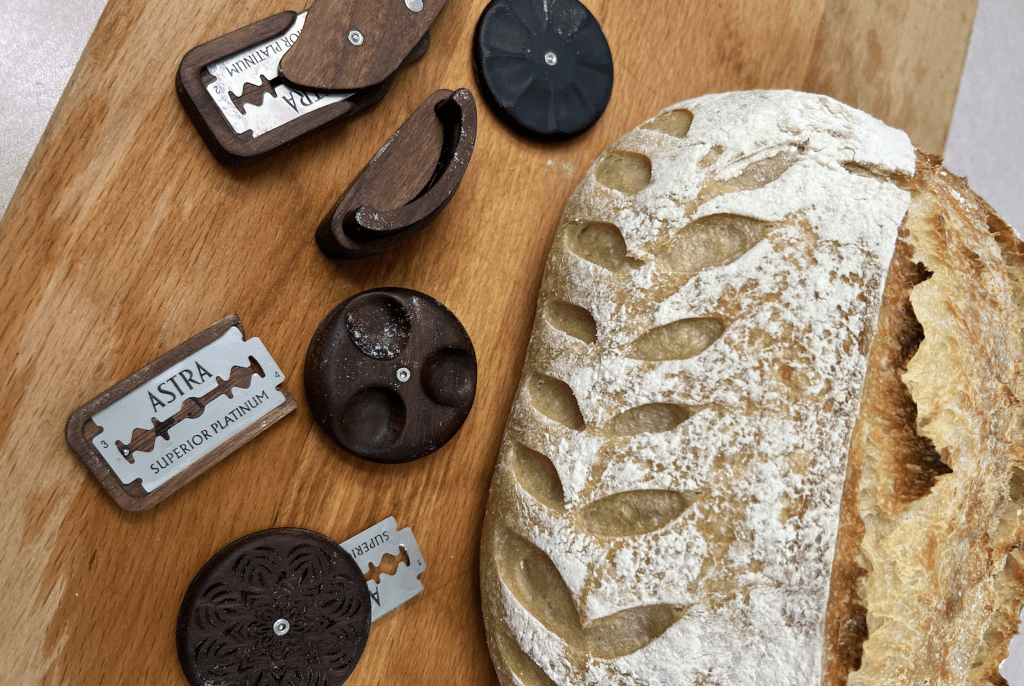In the fragrant realm of baking, nestled deep within the heartland of French bread culture, a timeless tool is held in high regard – the lame de boulanger, or the baker’s blade. Its connection with sourdough, one of the most cherished types of bread in France and worldwide, traces an enchanting tale of culinary craftsmanship and tradition.
In its most basic definition, a lame (pronounced “lahm”) is a double-edged blade attached to a handle, which is utilized by bakers to score, or make shallow cuts in, bread dough prior to baking. This seemingly modest tool bears a majestic significance in the world of baking, not least in the French bread culture, and particularly in relation to sourdough bread.
The etymology of ‘lame de boulanger’ (baker’s blade in English) is intriguingly straightforward. ‘Lame’ hails from the French word for ‘blade’, while ‘boulanger’ is the term for ‘baker’. Together, they reference the tool’s purpose and its custodian, emphasizing its fundamental role in the process of breadmaking.
Artisanal bread, especially sourdough, has a special place in the heart of French culture. Each loaf is a celebration of the breadmaker’s art, embodying tradition, skill, and a deep understanding of nature’s gifts. Sourdough, with its characteristically tangy flavor and rustic texture, offers an artisanal authenticity that’s deeply woven into the fabric of France’s rich gastronomic tapestry.
In the process of making sourdough bread, the ‘lame de boulanger’ is pivotal. It’s not just about making superficial decorative cuts on the dough. Rather, these scores regulate the bread’s expansion in the oven. They essentially guide the loaf’s ‘oven spring’, allowing the baker to control the way the bread rips and ensuring a more predictable shape. Each slash is a deliberate, thoughtful stroke, defining the bread’s final aesthetic and structural appeal.
Furthermore, each type of bread, sourdough included, has its unique scoring patterns, often traditional and sometimes innovative. The patterns can range from a simple straight line to complex designs, reflecting the creativity and expression of the bakers themselves. In the case of the classic French sourdough, or ‘pain au levain’, a distinctive crosshatch pattern is common.
Yet, the lame’s purpose extends beyond the physicality of baking. It’s a symbol of the personal touch, the human hand that shapes the course of nature’s bounty into sustenance. It represents the baker’s intimate engagement with their craft, a testament to their dedication and passion.
Thus, the humble ‘lame de boulanger’ is not merely a tool; it’s the scribe that inscribes the baker’s soul onto each loaf of sourdough, the conductor that orchestrates the symphony of the oven’s alchemy. It is, in every sense, a reflection of the art and soul of French baking tradition.
In the heart of French bread culture, amidst wafts of freshly baked sourdough, the baker’s blade upholds a legacy. It captures the essence of French gastronomy – that perfect blend of time-honored tradition, artisanal skill, and personal creativity. It encapsulates the spirit of French sourdough: a tangible, edible piece of culture and history, crafted by hands that wield the lame with respect, expertise, and artistic flair.
Recipe to Make French Sourdough Bread With Your Lame de Boulanger
Embrace the aromas and flavors of the idyllic French countryside as we delve into the artisanal tradition of sourdough breadmaking. With the trusty lame de boulanger by our side, we’ll embark on a journey to craft our very own rustic French sourdough, or ‘pain au levain’, from scratch.
Ingredients:
- 150 grams of mature sourdough starter
- 350 grams of lukewarm water
- 500 grams of bread flour
- 10 grams of fine sea salt
Process:
The Prelude: Combining the Starter and Water Begin by blending your mature sourdough starter with lukewarm water in a large mixing bowl. The warmth aids the yeast within the starter, laying the groundwork for a thriving environment for fermentation.
Flour Incorporation: Crafting the Dough Gradually incorporate the bread flour into the mixture. Stir until all the flour is well absorbed, resulting in a shaggy, somewhat sticky dough. Cover this mixture with a damp cloth and let it rest for about 30 minutes. This period, known as autolyze, allows the flour to hydrate and enzymes to start breaking down the starches and proteins, making the dough easier to handle and shaping the final texture and taste of our bread.
Incorporating Salt: Balancing the Flavor After the resting period, sprinkle the fine sea salt across the dough’s surface. Fold the dough onto itself a few times to integrate the salt, then cover again for another 30 minutes.
Bulk Fermentation: Cultivating the Sourdough Character Now, we enter the phase of bulk fermentation. Over the next 3-4 hours, perform gentle stretch and fold maneuvers every 30-45 minutes. This action not only develops the gluten network but also aerates the dough, encouraging our dough to rise and take on the distinctive sourdough character.
Shaping and Second Rise: Crafting the Loaf After bulk fermentation, turn the dough onto a lightly floured surface. Shape it into a round loaf, or “boule”, by pulling the edges towards the center, then flip the dough so the seam side is down. Let it rest for 20 minutes. Afterward, shape the loaf again as desired and place it seam-side-up in a well-floured proofing basket or bowl. Cover and let it rise for 2-3 hours, or until nearly doubled in size.
Scoring with the Lame de Boulanger: The Signature Touch Now comes the moment to wield our baker’s blade, the lame de boulanger. Carefully transfer your loaf, seam-side-down, onto a baking sheet lined with parchment paper. Gracefully score the top of the dough, creating a pattern of your choice – perhaps the classic crosshatch or a more personal design. These scores will guide the dough’s expansion in the oven, controlling the crust’s final appearance and the bread’s overall shape.
The Bake: The Culmination Preheat your oven to 240 degrees Celsius (475 degrees Fahrenheit) with a dutch oven or a baking stone inside. If you’re using a dutch oven, carefully place your scored dough inside, cover, and bake for 30 minutes. Then, uncover and bake for an additional 15-20 minutes until the loaf is beautifully golden and sounds hollow when tapped on the bottom. If using a baking stone, slide your loaf onto the preheated stone and bake for about 45 minutes, mist-spraying the oven occasionally during the first 10-15 minutes to create steam and encourage a better crust development.
Cooling: The Final Flourish Patience is essential in the final stage of the breadmaking process. After removing the golden-brown loaf from the oven, resist the temptation to dive straight in. Instead, allow it to cool completely on a wire rack. This resting period is crucial; it allows the residual heat to finish cooking the interior, and the crust to firm up, resulting in a perfect crumb and texture.
Voila! Now, you have your own homemade traditional French sourdough bread, a rustic ‘pain au levain’, bearing the signature of your hands and your lame de boulanger. Each loaf is a testament to the time, care, and skill invested – a tangible, edible piece of the French countryside brought to life in your own kitchen.
As you slice into the bread, you’ll reveal the fruits of your labor. The crust, crisped to perfection, will crackle slightly under the pressure of the knife, revealing the soft, aromatic interior. The distinctively tangy flavor of the sourdough, balanced by the subtly salty notes, is a celebration of simple, natural ingredients transformed through time and skill into something truly special.
Enjoy this bread as the French do – slathered with butter, adorned with your favorite cheese, or simply on its own to savor the intricate flavors. Whether for breakfast, lunch, or dinner, this traditional French sourdough bread recipe is a sure way to transport your senses straight to the heart of rural France. And with each loaf you bake, you become an essential part of the rich, ever-evolving tapestry of French breadmaking culture.





















